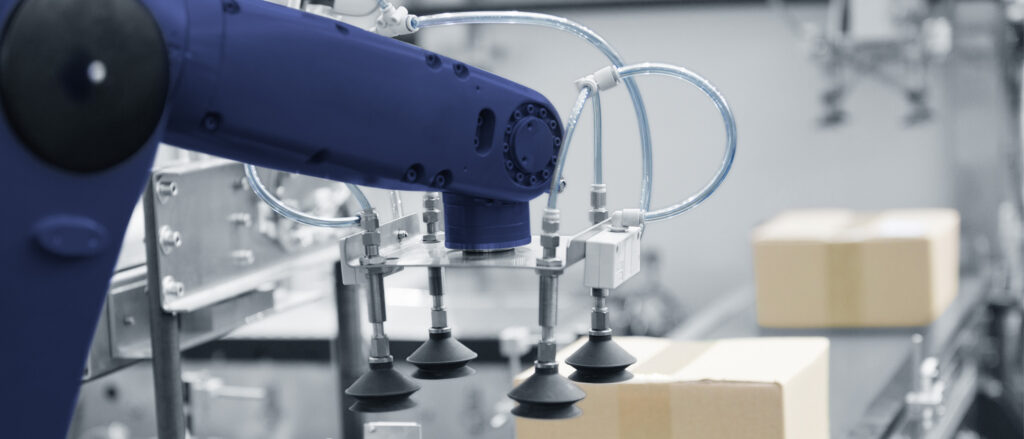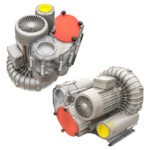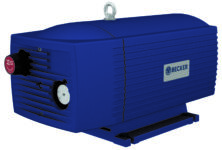
Strange noises, slipping production, and inconsistent suction can all be signs a vacuum pump is not keeping up with the demands of a secondary packaging application.
We take a look at eight telltale signs that indicate a secondary packaging pump is underperforming and what you, as a packaging equipment supplier or end user, can do about it.
In many cases, timely maintenance or a factory repair by the manufacturer can fix the problem. In others, it might be time for a conversation about a replacement pump better suited to the demands of your application and production schedule. Read on to learn how to spot equipment that’s falling behind.
FLAGGING PUMP TROUBLE: 8 TELLTALE SIGNS
If you’re an end user or OEM relying on vacuum pumps for secondary packaging applications from tray forming to palletizing, then you know how important strong, consistent vacuum pressure is to maintain production and ensure the final quality of your product.
Problems with a vacuum pump may start small but can begin to affect the efficiency of your line before you know it, especially if you’re not using equipment designed specifically for the needs of your application.
Here are eight symptoms to look out for that might indicate an underperforming secondary vacuum pump.

1. INCREASED OR UNUSUAL NOISE
Changes in the amount or type of noise a vacuum pump produces can be the first indication of trouble—indicating wear, internal damage, or another malfunction.
2. VACUUM FLUCTUATIONS
Falling or inconsistent vacuum will immediately affect your operation. Slipping or misaligned cartons, improperly formed trays, or dropped boxes are just some signs that a pump vacuum could be low or fluctuating.
3. LOWER PRODUCTION
Slowing operation or unexpected downtime can indicate a pump that’s struggling to maintain the required suction pressure. At this point, pump problems are already directly affecting your production, so it’s time to take action.
4. INCREASED ENERGY CONSUMPTION
Vacuum pumps are major drivers of operating costs. Spiking consumption may be the first indication that a unit is struggling to do its job. Act now to keep energy overheads under control.
5. OVERHEATING
A pump running hotter than usual is a classic sign of internal stress. It’s also a serious safety hazard. The longer you let an overheating pump run, the greater the chance of serious damage or a complete pump failure.
6. LONGER PUMP-DOWN TIMES
Rapid pump-down times are a key performance variable for hard-working secondary packaging pumps. While cheaper pumps generally have longer pump-down times, if your unit is taking longer to reach working pressure after a restart, you may have a problem.
7. INCREASED OIL MIST
Quality oil-flooded pumps should produce little or no “oil mist “ when operating. Excessive oil mist may be a sign of increased internal heat and pressure. Take action to remedy the problem and prevent further contamination of your work area.
8. INCREASED MAINTENANCE
If a pump starts to burn through replacement parts like filters, separators, or gaskets faster than it should, it may indicate an underlying problem. Keeping an eye on recommended maintenance intervals might help you flag potential problems early.
COMMON CAUSES OF PUMP UNDERPERFORMANCE
Multiple symptoms often point to just a few causes of pump stress. These can include both maintenance and design issues, as well as problems with your line setup or design. Here are some of the common causes of secondary packaging vacuum pump underperformance.
MISSED MAINTENANCE
Skipping or delaying scheduled maintenance checks can lead to wear and tear that goes unnoticed until it becomes a bigger issue. Clogged internal air filters and oil separators can allow a unit to overheat, damaging pump vanes and bearings and potentially leading to a pump failure.
DUSTY ENVIRONMENTS
Atmospheric dust from bulk food products or packaging fibers is common in food packaging environments and poses a particular threat to pumps if filters are not maintained.
Accumulated dust can damage the vanes in rotary vacuum pumps and clog oil lines in flooded units, causing overheating, wear, and inefficiency.
IMPROPER CLEANING
Inappropriate cleaning methods or materials, such as using water without proper protection, can also introduce contaminants into the pump and lead to malfunctions. This is a particular risk in food packaging plants that need to be kept sanitary.
INCORRECT PUMP CAPACITY
Choosing a pump with either too much or too little capacity for the job can lead to inefficiency and wear, thereby increasing maintenance needs and reducing equipment life. It’s crucial to work with your pump’s manufacturer to match its capacity with the needs of your packaging application.
INCORRECT PUMP DESIGN
Pump performance needs to be matched to the unique needs of your application. Using an off-the-shelf pump that is not designed for your specific operation can also lead to early wear, reduced performance, and increased maintenance.
The best equipment suppliers work closely with pump manufacturers to match equipment specs to the demands of a particular process.
INCORRECT PLUMBING SIZING
If the piping or tubing connected to the pump is not correctly sized, it can restrict flow or create unnecessary resistance, diminishing the pump’s effectiveness while increasing wear and potentially causing long-term damage to your equipment.
Pump equipment needs to be integrated with the correct inlet size to ensure an effective and efficient vacuum across the entire connected system.
POOR QUALITY EQUIPMENT
There’s no substitute for professional-grade, purpose-designed equipment. Opting for cheaper, off-the-shelf equipment might seem like a short-term win, but can cost you more in maintenance, downtime, and equipment overhauls in the long run.
If you’re committed to delivering safe, efficient secondary packaging at scale, you need reliable, industrial-grade vacuum pumps designed for the task at hand.
PUMP UNDERPERFORMANCE: WHAT YOU CAN DO
Here’s what you can do to prevent a pump from failing prematurely or to get equipment that is already underperforming back to peak condition.
1. STICK TO MANDATED MAINTENANCE SCHEDULES
Consult your manuals or check with the manufacturer about the ideal maintenance intervals for your equipment. Or even better, sign up for a scheduled maintenance service.
Make sure filters, separators, and oil are all changed as required and check that your pump’s gaskets and vanes are in good condition. Some manufacturers even supply ready-packaged maintenance and repair kits to make upkeep as easy as possible.
2. VANE REPLACEMENT
Where damage to your pump’s vanes has already occurred and is affecting performance, replacing these vanes can be cheaper than replacing or rebuilding a unit and should restore your machine to optimum performance.
Higher-quality units are generally easier to service in this way and reputable manufacturers are more likely to have original replacement parts available years or even decades after your pump was installed.
3. FACTORY REPAIRS
Where bearings or the electric motor itself have been damaged due to contamination or a lack of maintenance, it may be necessary to rebuild the entire pump. While this may be necessary to extend the life of a unit, it might be more cost-effective to replace some older or cheaper pumps.
On the other hand, leading equipment manufacturers including Becker offer vacuum pump overhauls and rebuilds at their facilities by their own trained technicians.
4. PUMP REPLACEMENT
Where a unit has been irretrievably damaged, has become too inefficient, or is just unsuitable for the application it was being used for, it may become necessary to replace the unit.
You can invest in the long-term efficiency and profitability of equipment by ensuring the replacement pump is up to the job. Choose high-quality equipment that’s designed for your application and is backed up by after-sale service and support from a reputable supplier.
5. PLANT-WIDE AUDITS
Where a pump is experiencing repeated problems or more than one pump unit is failing, it might help to have experts from your pump manufacturer visit your plant. Companies like Becker can help you pinpoint plant-wide problems like dust or inadequate plumbing. They can also predict, prevent, and mitigate continuing pump underperformance.
PREVENT PUMP PROBLEMS. MAKE IT BECKER.
Today’s high-speed, high-efficiency secondary packaging applications need tough, reliable vacuum pumps right-sized to the demands of your line equipment.
Becker is the single biggest supplier of vacuum pumps to the global packaging industry. Each of our models is purpose-designed for specific applications and available in a range of pump capacities to meet your needs.
As a pioneer in developing dry-vane pump technology, our clean-running oil-less rotary vane vacuum pumps, oil-lubricated pumps, robust hook-and-claw units, and efficient SV regenerative blowers offer best-in-class solutions to secondary packaging operations worldwide.
Whether you’re looking for vacuum pumps for secondary packaging or almost any other industrial application, Becker offers:
- The right product for the job: Our efficient, quiet-running pumps deliver the fastest pump-down times and maximum pressure of 0.1 millibar absolute, and are designed to be compact enough to fit on the tightest lines.
- Industry-leading expertise: Bring us your challenges. Our knowledgeable, experienced staff will evaluate your needs and recommend a product from our wide range of all-ways-in-stock inventory, or work with you to build a customized solution.
- The best customer service: We support our long-running products with on-site maintenance by our mobile service teams, genuine Becker replacement parts, and factory repairs by trained Becker technicians. We’ll even provide a pump rental for you while we repair or rebuild yours.
Quality equipment creates quality business. If you’re serious about delivering long-term value to your customers and profitability to your stakeholders, then choose a serious pump and compressor provider.
Choose wisely. Make it Becker. Click below to learn about Becker vacuum pumps built with your needs in mind.




